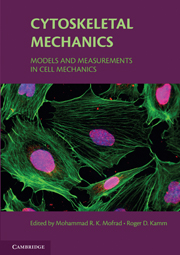Book contents
- Frontmatter
- Contents
- List of Contributors
- Preface
- 1 Introduction, with the biological basis for cell mechanics
- 2 Experimental measurements of intracellular mechanics
- 3 The cytoskeleton as a soft glassy material
- 4 Continuum elastic or viscoelastic models for the cell
- 5 Multiphasic models of cell mechanics
- 6 Models of cytoskeletal mechanics based on tensegrity
- 7 Cells, gels, and mechanics
- 8 Polymer-based models of cytoskeletal networks
- 9 Cell dynamics and the actin cytoskeleton
- 10 Active cellular protrusion: continuum theories and models
- 11 Summary
- Index
2 - Experimental measurements of intracellular mechanics
Published online by Cambridge University Press: 10 November 2009
- Frontmatter
- Contents
- List of Contributors
- Preface
- 1 Introduction, with the biological basis for cell mechanics
- 2 Experimental measurements of intracellular mechanics
- 3 The cytoskeleton as a soft glassy material
- 4 Continuum elastic or viscoelastic models for the cell
- 5 Multiphasic models of cell mechanics
- 6 Models of cytoskeletal mechanics based on tensegrity
- 7 Cells, gels, and mechanics
- 8 Polymer-based models of cytoskeletal networks
- 9 Cell dynamics and the actin cytoskeleton
- 10 Active cellular protrusion: continuum theories and models
- 11 Summary
- Index
Summary
ABSTRACT: Novel methods to measure the viscoelasticity of soft materials and new theories relating these measurements to the underlying molecular structures have the potential to revolutionize our understanding of complex viscoelastic materials like cytoplasm. Much of the progress in this field has been in methods to apply piconewton forces and to detect motions over distances of nanometers, thus performing mechanical manipulations on the scale of single macromolecules and measuring the viscoelastic properties of volumes as small as fractions of a cell. Exogenous forces ranging from pN to nN are applied by optical traps, magnetic beads, glass needles, and atomic force microscope cantilevers, while deformations on a scale of nanometers to microns are measured by deflection of lasers onto optical detectors or by high resolution light microscopy.
Complementary to the use of external forces to probe material properties of the cell are analyses of the thermal motion of refractile particles such as internal vesicles or submicron-sized beads imbedded within the cell. Measurements of local viscoelastic parameters are essential for mapping the properties of small but heterogeneous materials like cytoplasm; some methods, most notably atomic force microscopy and optical tracking methods, enable high-resolution mapping of the cell's viscoelasticity.
A significant challenge in this field is to relate experimental and theoretical results derived from systems on a molecular scale to similar measurements on a macroscopic scale, for example from tissues, cell extracts, or purified polymer systems, and thus provide a self-consistent set of experimental methods that span many decades in time and length scales. At present, the new methods of nanoscale rheology often yield results that differ from bulk measurements by an order of magnitude.
- Type
- Chapter
- Information
- Cytoskeletal MechanicsModels and Measurements in Cell Mechanics, pp. 18 - 49Publisher: Cambridge University PressPrint publication year: 2006
- 3
- Cited by



